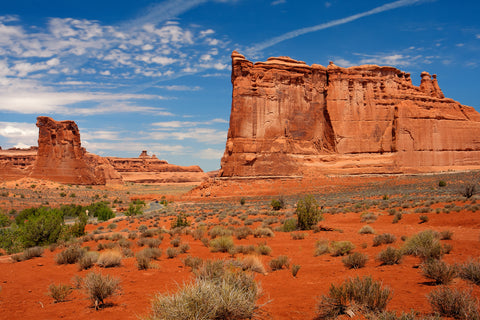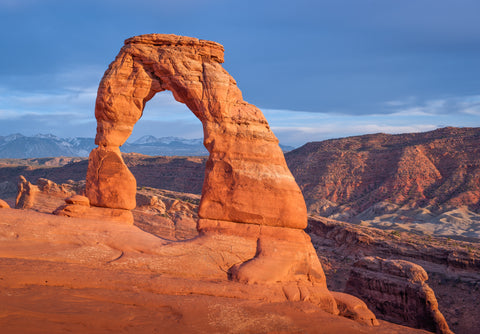Where is Arches National Park
In western Utah, only an hour from the Colorado border, lies a national treasure and state gem. Arches National Park is a natural wonder in the heart of the Colorado Plateau, featuring stunning geological formations including the famed red rock arches. The Colorado River runs along the southern border of the park. Moab, Utah lies just south of Arches National Park. Canyonlands National Park is just a 30 minute drive southwest. The La Sal Mountains are only a little over an hour to the southeast.

How Big is Arches National Park
Arches National Park covers more than 119 square miles, or roughly 76,500 acres. The park gets its name from the red rock arches that dot the park. There are over 2,000 of them! The tallest arch is Double Arch South at 112 feet. The longest arch is Landscape Arch stretching 306 feet. The lowest elevation in the park is the Visitor Center sitting at 4,085 feet. The highest point in the park is Elephant Butte raising to an elevation of 5,653 feet.
Arches National Park Weather
The high desert region where Arches resides experiences sweeping temperature fluctuations, sometimes more than 40º F. Winter is the coldest time. Days reach 30ºF-50ºF and nights fall to 0ºF-20ºF. The park sees a minimal amount of snow and ice, but enough that some trails become impassible. Spring is a popular season. The days average around 60ºF-80ºF with mostly clear skies. Night time lows are around 30ºF-50ºF. Some rainstorms are possible. Fall is another popular season as the weather is about the same as Spring. Be careful during Summer, the most extreme season. Violent thunderstorms are extremely common. Flash flooding can occur during or after a storm. The days are long, dry and intensely hot. Temperatures generally reach well over 100ºF.

When did Arches become a National Park
Arches National Park has a rich history. President Herbert Hoover established the area as a National Monument in 1929. During the Nixon administration, in 1971, the area became a National Park. The park has been a filming site for more than 40 movies including Fort Apache (1948), Hulk (2003) and Indiana Jones and the Last Crusade (1989).

Things to do in Arches National Park
Not sure what to do when you get to Arches? Our National Park Visitors Guide has a quick top ten list of the most popular attractions at Arches and when to see them.

Delicate Arch
This formation is the most iconic part of Arches National Park. The arch is 52 feet tall, freestanding, and natural. The trail to Delicate Arch is only 3 miles round trip. This is one of the most popular destinations in the park, so get there early to beat the crowds!
Landscape Arch
Landscape Arch is the longest arch in the park and an impressive sight to see. Despite stretching more than 300 feet, the arch is only about 11 feet thick at the center. The hike is rated as easy to moderate, only 1.6 miles roundtrip.
Devils Garden
Devils Garden is rife with stone fins and arches. The Devils Garden trail covers more than 7 miles, branching off into smaller trails, loops and sections. There is also a picturesque campground here with more than 50 campsites. Sites fill up fast so book ahead!
Balanced Rock
Balanced Rock is one of the most iconic formations in the park. The rock on a stone pedestal formation is 128 feet tall. The balanced rock alone weighs approximately as much as 27 blue whales! The formation features a trail that leads completely around it.
Fiery Furnace
Located near the center of the park is Fiery Furnace. The area is a group of canyons, arches and fins guests can hike through. The passages are narrow but the views are worth it. Hike alone with a permit or go on a ranger-guided tour.
Animals in Arches
Arches National Park is home to many critters, most of which beat the heat by being nocturnal. Some of these animals include kangaroo rats, bobcats and bats. Other animals prefer dusk and dawn, which is called crepuscular. Animals like this include songbirds, coyotes, and porcupines. Diurnal animals are day dwellers like lizards, snakes and squirrels.
Rock Climbing
Arches is one of the free climbing capitals of the world. US National Park visitors flock from across the globe to scale the red rock formations of the park. Get a permit first and only climb in designated climbing areas. Chalk should match the color rock being climbed.
Slickrock Bike Trail
This trail is world famous. Slickrock is challenging both technically and physically. It is a 10.5 mile trail that leads over petrified dunes and what remains of prehistoric seabeds. The trail is popular, so get there early during peak season to beat the crowds.
Horseback Riding
Get around the park in style on a horse (or mule). Horseback is one of the most popular ways to view Seven Mile Canyon. The use of pack animals is only permitted during day trips. There are several options outside the park for renting horses.
Hiking Trails
There are many hiking trails in Arches National Park ranging from easy to challenging in difficulty. Trails wind through the desert and around stone arches that are only visible to those that venture off the road. Keep off arches for your safety and their preservation.

When to go to Arches National Park
There’s no right way to enjoy Arches National Park. It’s open all year long. The season you should visit depends on you. The most temperate times to visit are spring (April through May) and fall (September through October). During the day, the temperature averages 60°F to 80°F. Most days have clear, sunny skies. The park is fully open, but full of guests. The heat can be extreme in the summer (June through August). Days can easily reach an excess of 100°F. Thunderstorms are also common during the summer, which can cause flash flooding. Winter is a time of tranquil beauty. Many facilities have closed for the season and the crowds are gone. Snow and ice is possible on the trail.
Must-Have things to bring to Arches
Don’t get caught unprepared on your adventure at Arches! Make the most of your trip by bringing some essential supplies. Here’s a quick list of what you need to pack.
Water
Arches National Park gets about an inch of precipitation a month - it is bone dry! You’ll need to bring your own water to survive. There are very few bodies of water here. The water in Arches is not recommended for use with a hydration filtration device.
Food
Keeping your energy levels up is imperative to being able to hike out in the desert heat. Food options are slim at the park. Bring your own meals and snacks so you can spend your days exploring the park and having fun in the sun.
Sun Protection
The sun will scorch you if you’re not careful. Sunburn, heat stroke and severe dehydration are all very serious conditions that could end your trip early. Protect yourself from the sun by wearing sunglasses and a wide-brimmed hat. SPF 50+ Sunscreen is also a must.

Hiking Boots
Arches’ hiking trails are sandy, rocky and rugged. Save yourself from sprains and bruises by bringing proper footwear. Sturdy hiking boots that are already broken in are recommended. A good pair of hiking boots will also help protect you from snakes, spiders and scorpions.
Lip Balm
Getting dehydrated is easy to do out in the scorching hot desert. Being thirsty dries out your lips. So does being in the sun. Prevent dry, cracked, chapped lips with lip balm. You can even get lip balm with SPF for added sun protection.
First Aid Kit
Even the best laid plans can go awry and accidents happen. If you’re out on the trail and sustain an injury, a first aid kit will help you get back to hiking. If something serious happens, the first aid kit could even save your life.
Bug Spray
Mosquitos are prevalent at the park, except during winter. The best way to avoid the annoyance and pain of being bitten is to bring some bug spray. You can also use a different method of bug repellent if you prefer.
Blacklight Flashlight
Arches is home to scorpions, a type of arachnid. They hide under rocks during the day, coming out during the cool of the night. You will have a hard time spotting them in the dark unless you have a blacklight. Their exoskeletons glow under blacklight.
Where to stay in Arches National Park
Arches National Park has only one campground at Devils Garden. The campground features more than 50 campsites. You must make reservations if you plan on camping here May through October. From November to April the campsites are offered on a first-come, first-served basis. There are a few back-country sites for backpackers, but you must have a permit to use. There are plenty of other places to stay in Moab including hotels, cabins, and private campgrounds.

Food Nearby Arches
You'll want to bring food for your trip to Arches. There are no restaurants or groceries inside the park. The Visitor Center offers extremely limited supplies. The park features several picnic areas throughout the park, plus the campgrounds have campfire rings and primitive grills. There are, however, excellent eateries and restaurants in Moab, about 5 miles from the park entrance.
Airports near Arches National Park
There are two airports near Arches National Park. The closest option is Grand Junction Regional Airport one and a half hours away. This airport receives flights from Salt Lake City, Denver, Phoenix and Dallas. The next closest option is Salt Lake City International Airport. It’s three and half hours from Arches. It’s a major airport with domestic and international flights.

